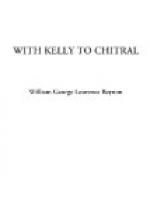CHAPTER VII
THE FIGHT AT NISA GOL
Next morning, 13th April, we were all having a good square breakfast by 6 A.M., and punctually at seven o’clock the column moved off, headed by the Levies.
Our force consisted of—
400 Pioneers,
100 Kashmir Infantry, 40 Kashmir Sappers,
2 Mountain guns,
100 Hunza and Punyal Levies;
rather less than a single battalion, and not much with which to force our way through seventy miles of bad country, but still we were determined to get to Chitral before the Peshawur force.
It was a perfect morning, nice bright sunshine, and a jolly fresh feeling in the air, sort of day that makes you want to take a gun and go shooting; in fact, just the very day for a fight.
The Levies were across Oldham’s bridge in no time, but the Pioneers had to cross it slowly, as it was very jumpy, and only four men could be allowed on it at a time. The guns were sent up to a ford some three hundred yards up the stream. After crossing the main stream there was still a creek to be forded, but this was not much above the men’s knees. This gave the Levies time to get ahead and send some scouts up the hills to the right, in order to give timely warning if the enemy should try on the rolling stone dodge, but the hills just here did not lend themselves very readily to this mode of warfare. When our little army got across the river, the advance guard was halted and the column formed up, and then on we went. Peterson was in command of the advance guard, with orders to halt when he reached the edge of the plain to allow the column to close up for the attack. On the order to advance he was to hug the hill on his right.
Just before the maidan the road drops down on to the river bed, and then runs up on to the maidan itself, which gradually slopes up to the centre, where it is divided by a deep nullah that I think they call in America a canon. The sides of this nullah are in most places perpendicular, varying from two hundred and fifty to three hundred feet in depth, with a small stream running along the bottom, the amount of water depending on the melting of the snow in the hills above. There are two places to cross it, one the regular road to Chitral, which zig-zags down the nullah near the mouth, and the other a goat track about half-way between the road and the hills. Both of these had sangars covering their approach on the enemy’s side of the nullah, and any attempt to rush them would have led to great loss of life.
To the casual observer the plain looks perfectly flat, but as a matter of fact the slope is rather more pronounced at the foot than at the top near the hills, with the result that from the sangar covering the main road, the upper end of the plain is partially hidden from fire.
The plain also is really a succession of what may be described as waves running parallel with the nullah, which afford very excellent shelter to any attacking force. In fact, the only obstacle is the nullah; but, as you may see from the photos, this obstacle is no small one, and could only be crossed by two paths as far as we knew. Our object was to find another path, and to get to close quarters with the enemy.




